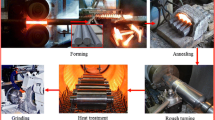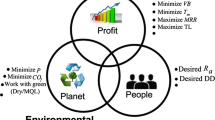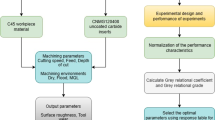Abstract
The current work examines the performance of Minimum Quantity Lubrication when turning of EN-GJL-250 cast iron compared to dry and wet cooling methods. The Taguchi design L36 has been chosen for the planification of experimentation. Then, ANOVA has been established after data acquisition in order to define the effect of cutting conditions such as the used inserts, cutting depth, feed rate and cutting speed on the studied factors. Furthermore, the surface roughness has been deeply studied using 3D roughness topography to evaluate the MQL effect. Finally, the approach ANN-MOALO was found to be helpful for future industrial applications for predicting part quality and power consumption with accurate results and optimizing cutting parameters that helps to achieve the best production control.







Similar content being viewed by others
References
Merchant ME (1998) An interpretive look at 20th century research on modeling of machining. Mach Sci Technol 2(2):157–163
Çalışkan H, Kurbanoğlu C, Panjan P, Čekada M, Kramar D (2013) Wear behavior and cutting performance of nanostructured hard coatings on cemented carbide cutting tools in hard milling. Tribol Int 62:215–222
Abdalla HS, Baines W, McIntyre G, Slade C (2007) Development of novel sustainable neat-oil metal working fluids for stainless steel and titanium alloy machining. Part 1. Formulation development. Int J Adv Manuf Technol 34(1-2):21–33
Koné F, Czarnota C, Haddag B, Nouari M (2013) Modeling of velocity-dependent chip flow angle and experimental analysis when machining 304L austenitic stainless steel with groove coated-carbide tools. J Mater Process Technol 213(7):1166–1178
Heine HJ (1998) Dry machining: A promising option. Foundry Manag Technol 126(8)
Lawal SA, Choudhury IA, Nukman Y (2012) Application of vegetable oil-based metalworking fluids in machining ferrous metals—a review. Int J Mach Tools Manuf 52(1):1–12
Brockhoff T, Walter A (1998) Fluid minimization in cutting and grinding. Abrasives J Abrasives Eng Soc 10(11):38–42
Chalmers RE (1999) Global flavor highlights NAMRC XXVII. Manuf Eng 123(1)
Jayal AD, Balaji AK (2009) Effects of cutting fluid application on tool wear in machining: interactions with tool-coatings and tool surface features. Wear 267(9-10):1723–1730
Autret R, Liang SY, Woodruff GW (2003) Minimum quantity lubrication in finish hard turning. Proceedings of international conference on humanoid, nanotechnology, information technology communication and control, environment, and management, Manila
Wattoo KR, Khan MZ, Israr A, Amin M (2021) A novel study on the effects of minimum quantity lubrication and machining parameters in turning of Ti-6Al-4V Alloy By Applying Al2O3-Graphene hybrid nanoparticle enriched cutting fluid
Dhar NR, Kamruzzaman M, Ahmed M (2006) Effect of minimum quantity lubrication (MQL) on tool wear and surface roughness in turning AISI-4340 steel. J Mater Process Technol 172(2):299–304
Dhar NR, Ahmed MT, Islam S (2007) An experimental investigation on effect of minimum quantity lubrication in machining AISI 1040 steel. Int J Mach Tools Manuf 47(5):748–753
Nipanikar Mr, Suresh R, Sargade VG (2020) Effect of process parameters during turning of Ti6Al4V-ELI in Dry and MQL environments. Int J Eng Res Technol (Ijert) 8:190–194
Mishra RR, Sahoo AK, Panda A, Kumar R, Das D, Routara BC (2020) MQL machining of high strength steel: a case study on surface quality characteristic. Mater Today Proc 26:2616–2618
Kumar S, Singh D, Kalsi NS (2017) Analysis of surface roughness during machining of hardened AISI 4340 steel using minimum quantity lubrication. Mater Today Proc 4(2):3627–3635
Conger DB, Emiroglu U, Altan E (2019) An experimental study on cutting forces and surface roughness in MQL milling of aluminum 6061. Mach Technol Mater 13(2):86–89
Niknam SA, Jalali A (2020) Effects of lubricants and flow rates on the surface roughness and chip thickness when MQL turning of aero-engine aluminum alloys 6061-T6 and 7076-T6. Int J Adv Manuf Technol 110(7):2015–2022
Revuru RS, Zhang JZ, Posinasetti NR, Kidd T (2018) Optimization of titanium alloys turning operation in varied cutting fluid conditions with multiple machining performance characteristics. Int J Adv Manuf Technol 95(1):1451–1463
Bedi SS, Behera GC, Datta S (2020) Effects of cutting speed on MQL machining performance of AISI 304 stainless steel using uncoated carbide insert: application potential of coconut oil and rice bran oil as cutting fluids. Arab J Sci Eng 45(11):8877–8893
Sarkar S, Datta S (2021) Machining performance of inconel 718 under dry, MQL, and nanofluid MQL conditions: application of coconut oil (base fluid) and multi-walled carbon nanotubes as additives. Arab J Sci Eng 46(3):2371–2395
Mirjalili S (2015) The ant lion optimizer. Adv Eng Softw 83:80–98
Nouioua M, Yallese MA, Khettabi R, Belhadi S, Mabrouki T (2017) Comparative assessment of cooling conditions, including MQL technology on machining factors in an environmentally friendly approach. Int J Adv Manuf Technol 91(9):3079–3094
Laouissi A, Yallese MA, Belbah A, Belhadi S, Haddad A (2019) Investigation, modeling, and optimization of cutting parameters in turning of gray cast iron using coated and uncoated silicon nitride ceramic tools. Based on ANN, RSM, and GA optimization. Int J Adv Manuf Technol 101(1):523–548
Yusup N, Zain AM, Hashim SZM (2012) Overview of PSO for optimizing process parameters of machining. Procedia Eng 29:914–923
Meddour I, Yallese MA, Bensouilah H, Khellaf A, Elbah M (2018) Prediction of surface roughness and cutting forces using RSM, ANN, and NSGA-II in finish turning of AISI 4140 hardened steel with mixed ceramic tool. Int J Adv Manuf Technol 97(5):1931–1949
Mirjalili S, Jangir P, Saremi S (2017) Multi-objective ant lion optimizer: a multi-objective optimization algorithm for solving engineering problems. Appl Intell 46(1):79–95
Le Breton H (1966) Manuel pratique du fondeur de fonte: Lycées techniques, collèges d’enseignement technique, cours de perfectionnement de maîtrise. Dunod
Nouioua M, Yallese MA, Khettabi R, Belhadi S, Bouhalais ML, Girardin F (2017) Investigation of the performance of the MQL, dry, and wet turning by response surface methodology (RSM) and artificial neural network (ANN). Int J Adv Manuf Technol 93(5):2485–2504
Nouioua M, Yallese MA, Khettabi R, Chabbi A, Mabrouki T, Girardin F (2017) Optimization of machining process during turning of X210Cr12 steel under MQL cooling as a key factor in clean production. In: International conference design and modeling of mechanical systems. Springer, Cham, pp 855– 863
Yi P, Liu Y, Fan C, Zhan X, Xu P, Liu T (2017) Impact analysis of the thermal mechanical coupling characteristics of graphite morphologies during laser cladding of gray cast iron. Opt Laser Technol 90:52–64
Funding
The work is financed by the Algerian Ministry of Higher education and Scientific Research.
Author information
Authors and Affiliations
Corresponding author
Ethics declarations
Ethics approval
I certify that the paper follows the ethical rules of good scientific practice mentioned in the “Ethical Responsibilities of Authors” of the journal.
Consent for publication
I, Aissa Laouissi, hereby declare that I participated in the study and in the development of the manuscript titled (Machinability study and ANN-MOALO-based multi-response optimization during Eco-Friendly machining of EN-GJL-250 cast iron) and authorize the full the publishing of manuscript data.
Conflict of interest
The authors declare no competing interests.
Additional information
Availability of data and material
Not applicable
Code availability
Not applicable
Additional declarations for articles in life science journals that report the results of studies involving humans and/or animals
Not applicable
Consent to participate
Not applicable
Publisher’s note
Springer Nature remains neutral with regard to jurisdictional claims in published maps and institutional affiliations.
Rights and permissions
About this article
Cite this article
Laouissi, A., Nouioua, M., Yallese, M.A. et al. Machinability study and ANN-MOALO-based multi-response optimization during Eco-Friendly machining of EN-GJL-250 cast iron. Int J Adv Manuf Technol 117, 1179–1192 (2021). https://doi.org/10.1007/s00170-021-07759-z
Received:
Accepted:
Published:
Issue Date:
DOI: https://doi.org/10.1007/s00170-021-07759-z




